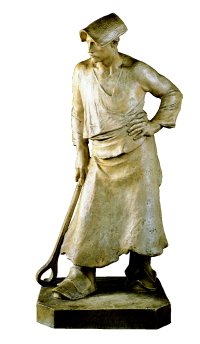An Iron Worker Returns to Pittsburgh

Belgian sculptor Constantine Meunier's famous figure of a European iron
worker is back in Pittsburgh to stay, 85 years after a highly popular first
visit in 1914. Curator Louise Lippincott says the four-foot plaster
figure is the most significant sculpture to be acquired by the Fine Arts
department in many years. "Meunier [1831-1905] is as good as Rodin,
and very different. He is much more interested in real subjects, and this
is his own actual model, not one of the mass-produced replicas made from
it. The condition is perfect—-basically untouched after it left the artist's
hands. Hammersmith was his most famous work, and it's one of the
best examples of the artist capturing the dignity and heroism of labor."
A hugely successful exhibition of Meunier's sculptures, paintings and
drawings toured six industrial cities in the United States in late 1913
and early 1914. The New York Times reported that 1500 people crowded into
the galleries in Pittsburgh in the first half-hour: "The keenest appreciation
has been shown by the men from the mines and factories of Pittsburgh, men
who are the very prototypes of the laborers depicted by Meunier."
American workers responded to Meunier's laborers-—diligent, efficient,
productive men—-more strongly than did European audiences. Historians attributed
the American crowds to the growing power of the labor movement in the United
States. Americans responded enthusiastically to art that revealed the honorable
work-ethic of the laborer, and a productive industrial society. In Chicago,
the exhibition was hailed as the "epic of modern industrialism," and Meunier
was called "the apostle of labor."
Acquisition of the sculpture was made possible by the Major Painting
Acquisition Fund and Robert S. Waters Charitable Trust.
|

